Swiss architects Jacques Herzog & Pierre de Meuron founded an architectural practice in Basel called “Herzog & de Meuron”. They won the competition for the Tate Museum causing a sensation all over the world: the first non-British architectural practice that won an important public role in England.
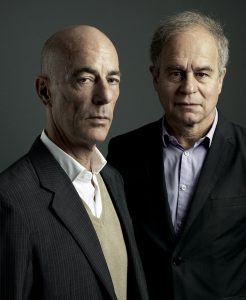
Image source: https://search.creativecommons.org/photos/8bfbdb68-be0a-4acd-8908-e56cbab81e95by 準建築人手札網站 Forgemind ArchiMedia
What Do We Know About These Architects?
The architects, both born in Basel in 1950, have been friends since the age of seven and have attended the same schools. They attended courses by Lucius Burckhardt, Dolf Schnebli and Aldo Rossi at the ETH Zurich University. The first years of university education followed a predominantly sociological and philosophical approach, influenced by the ideological legacy of ’68. In 1975, they graduated with an urban thesis on the city of Basel, indissolubly joining their professional career. In 1977, they became assistants of Schnebli. Both are dedicated to teaching and professional activities; they have been professors at Harvard from 1989 to 1994 and from 1999 at the Eth Polytechnic of Basel. Perhaps their highest-profile project is the completion of the conversion of the Bankside Power Station on the south bank of the Thames, in London, into a new Gallery of Modern Art for the Tate Modern Museum. This vistory caused a sensation all over the world: the first non-British architecture studio that won an important public role in England.
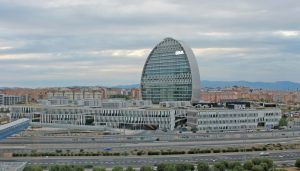
Image source: https://en.wikipedia.org/wiki/Herzog_%26_de_Meuron#/media/File:BBVA_head_offices_(Madrid)_08.jpg
They have carried out projects in England, France, Germany, Italy, Spain, Japan and Switzerland: from the Goet collection museum in Munich, to the Rémy Zaugg atelier, from the small comic book museum in Basel, to projects for the Prada fashion house in Arezzo, Tokyo and New York. In the United States, they have designed the De Young museum in San Francisco and an extension to the Walker Art Center in Minneapolis. The headquarters of the Hamburg Philharmonic and the glass tower of the Schatzalp in Davos. Among their great international works, the new Munich Allianz Arena, the Prada Epicenter Store in Tokyo and the Tate Gallery in London. The Swiss architects built the new Olympic stadium in Beijing and the new Basel tower for the new pharmaceutical multinational Roche MAM in Miami. In 2007, they received the 2007 Royal Gold Medal in London, as a recognition of the contribution to the cities and architecture of the whole world, from their first work in Switzerland to those performed in London as the Tate Modern, up to the most recent works of Barcelona and Tokyo.
Info source: http://www.archimagazine.com/bhed.htm
Herzog & de Meuron’s best know projects
- The Tate Modern
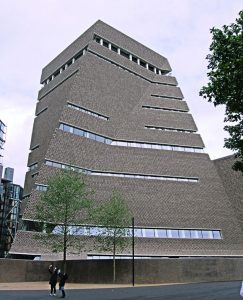
Image source: https://search.creativecommons.org/photos/38ab2d04-f58d-4536-8ddf-685aa5ecb8f9by:Jim Linwood
Twenty years ago, Jacques Herzog and Pierre de Meuron converted London’s Bankside power station into a gallery. The Swiss architects tackled the conversion with a relatively light hand, creating a contemporary public space without diminishing the historical presence of the building. The impressive cultural icon has become the most visited museum of modern art in the world, revitalizing its once-isolated industrial district. Herzog & de Meuron have chosen to enhance the urban character of the building without significantly diminishing its shape, allowing it to remain an experiential and visual piece in itself. The most apparent exterior alteration is the beam of light placed atop its roof, a horizontal contrast to the chimney. The minimal geometry of the light beam and the translucent glass clearly differentiate it from the dark masonry and the masonry details of the original façade. The transition between old and new is not always obvious. Heavy stair railings, cast iron grids and unfinished wood floors blend with the original aesthetic.
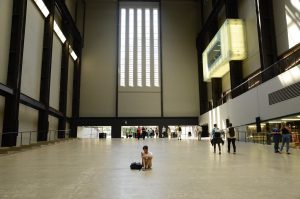
Image source: https://search.creativecommons.org/photos/6ea07f62-f05d-4afc-a90a-f26ec6c13ee4 by:Stephen Kelly Photography
By opening the landscape around the old power plant, the architects tried to give a natural approach to a seemingly monolithic building. The gardens mediate between the museum and the surrounding urban fabric, providing access from all four directions. The façade is perforated in bands at ground level, indicating the entrances and inviting the public inside. Herzog & de Meuron imagined the large space of the turbine room as a public square, allowing passage or a place of aggregation. To host a wide range of works of art, Herzog & de Meuron has replaced much of the interior of the power plant with tunnels of different sizes. They share a sober aesthetic, but vary in height from five to twelve meters, illuminated by a variety of natural and artificial lighting. The original windows of the power station cathedral extend from floor to ceiling in some galleries, echoing in rhythm and proportions from the skylights above the head. The translucent glass layers of the light beam have been specially designed to filter daylight and artificially replicate its qualities during the night.
Info source: https://www.archdaily.com/429700/ad-classics-the-tate-modern-herzog-and-de-meuron
- The Hamburg Philharmonic Orchestra
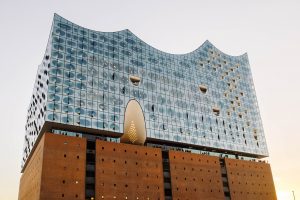
The new spectacular space for the Hamburg Philharmonic Orchestra signed by Swiss studio Herzog & de Meuron is a real container of services, with 520 parking spaces, five hotels, three restaurants, public spaces and private apartments. There was no shortage of unforeseen events and difficulties, which involved an additional outlay of 256.7 million charged to the city. But the increase in costs was almost € 550 million, equal to the difference between the first estimate of € 241 million of the construction cost and the final account. On the other hand, the work realized is grandiose, suggestive also for its location on a point of the port, which required a particular engineering commitment to support the 200 thousand tons of the structure.
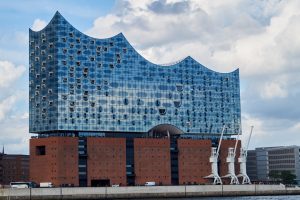
Image source: https://search.creativecommons.org/photos/f6999c25-fd03-4b61-9cf6-28fa4db0fc33 by Tobias Held
The large roof evokes a giant sail. In the great work imagined by the Swiss studio there is also a bit of made in Italy. Beginning with the façades that have been put in place by Josef Gartner GmbH, which is a subsidiary of Permasteelisa Group, the well-known company from Treviso specialized in architectural envelopes that it realizes all over the world. Antonio Citterio and Partners has designed interiors for private apartments; the Sunglass of Padua supplied the windows while Poltrona Frau provided the seats.
Which Are The Main Features Of Their Style?

Image source: https://search.creativecommons.org/photos/ca757a6f-c2e4-4e6e-93ce-3eb57aabde57by ansam61@hotmail.com
From contemporary art, Herzog and de Meuron learned that concept is more important than style – unlike other architects, Herzog and De Meuron avoid a signature look and instead seek almost obsessively to find a different set of materials, details and forms for almost every project. At the same time each, thanks to a consistent underlying attitude, is somehow recognizably theirs. They also learned to engage people in different ways, by combining the intellectual with the sensual: they like to build with substances that are fascinating and engaging. Their means include mud, black lava-like concrete, the multiple reflections of glass, copper, the printing of images on to glass, plastic or concrete such that a wall suddenly resembles the page of a book. They like to give their materials a perceptual twist, such as making the heavy look light or the transparent solid.
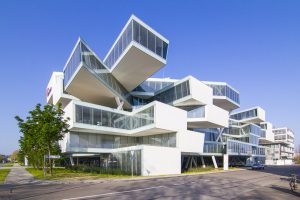
Image source: https://www.flickr.com/photos/wojtekgurak/34559536071 byWojtek Gurak
In some architectural partnerships there is a division of roles – one the artist, the other the businessman for example – but they have always insisted that theirs is an indistinguishable collaboration. They have complementary personalities. Herzog, shaven-headed, gym-toned, eloquent, alert with contained energy, is happy to be the public face of the practice. De Meuron has a more professorial manner and stays more in the background. Herzog has said that “the greatest inspiration is the existing world in all its ugliness and normality”. “The two of us from the beginning,” says De Meuron, “we were very interested in everything, not just canonic architecture from Egyptians up to modern times. Everything is interesting if you are ready and able to look at it.” Artists, says Herzog, are much better at uncertainty and instability than architects. Sympathy and collaboration with artists is a distinctive feature of Herzog and De Meuron’s architecture.
Info source: https://www.theguardian.com/artanddesign/2016/may/15/herzog-de-meuron-interview-tate-modern-switch-house-extension
